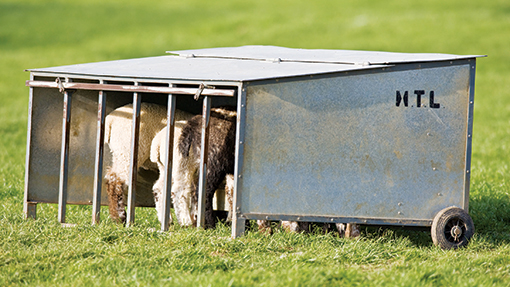Plan creep feeding now to optimise lamb growth

Sheep producers need to assess carefully the value of creep feeding lambs as a means of ensuring sustained lamb growth rates and achieving optimum efficiency in terms of output.
According to sheep consultant Lesley Stubbings, creep feeding shouldn’t be a knee-jerk reaction to poor performance or grass shortages.
She says creep feeding during the first 12 weeks of life will cost half as much as feeding a lamb in September to achieve compensatory growth lost earlier in the season. She recommends formulating a planned approach now for using creep feeding as part of this season’s lamb management.
‘£10 a lamb is a justified cost for us’
Creep feeding lambs through to slaughter is an integral part of Suffolk-based sheep producer Mike Mumford’s system. He runs 1,200 Scotch Mules, which start lambing in March, with the aim of finishing all the lambs by September.
“Our ewes and lambs are turned out on to leys that include a large area within a stewardship scheme, so we introduce creep feed to the lambs from two weeks old.
“This is to make up for any shortfall in grass quality and ensure we are continually pushing them on right through the season.
“We forward buy to try to get the best deal on creep and, while we do have a big concentrate bill, we believe the cost of about £10 a lamb is completely justified for the system we run,” says Mr Mumford.
Management of the leys is paramount to keeping the ewes milking well, but creep feeding is still considered to be essential.
“We get lambs away between 12 and 16 weeks on average to produce a UR 3L 20kg carcass for the local butchery trade. We feel the grass and the creep combine to give us an ideal level of finish and flavour for our buyers. That’s the positive feedback we get.”
Mr Mumford says without creep feeding he would not be able to market his lambs in the time period he wants to get them away.
“We’d be left with a lot of store lambs to feed in the winter and catch crops just don’t fit into our system on this heavy land.
“The creep feeding makes sure the ewes haven’t been pulled down too much and are in good condition at weaning, because we need the autumn grass for flushing the ewes before tupping.
“We do have to bite the bullet on cost, but we’ve set up a robust system based on creep feeding with the aim of getting a large percentage of lambs away before prices start to slip in midsummer.”
“When creep feeding has to be introduced as an emergency measure to try and salvage poor growth rates during the first three weeks of a lamb’s life, it will not achieve the same benefit that would have been gained if it had been offered earlier when feed conversion ratios were at their highest.
“But while creep feeding is an expensive way of feeding kilos of grass dry matter, when adequate planning is undertaken and a farmer does his sums correctly to make sure he uses creep feed as efficiently as he possibly can, it is definitely worthwhile.”
Ms Stubbings says while it is an expensive form of dry matter, sheep producers must not underestimate that lambs are converting it twice as efficiently that early in their growth cycle than they would later.
“Those are the key issues that really do need to be addressed, particularly with the unpredictability of seasonal weather and grass growth.” says Ms Stubbings.
Deciding factors
Sheep producers should consider the quality and quantity of grass they will have available and where the seasonal gaps are.
“If you’ve got a grass gap during the early stage of lactation – which a lot of farmers have – the lamb growth lost will never be recovered without supplementary feeding. They will never convert as efficiently again before slaughter,” says Ms Stubbings.
But she says when creep feeding is correctly planned, it can be used either as a vital support to growth from a very early age to about seven weeks and then withdrawn, or can be used right up to slaughter.
“In fact, producers who creep feed lambs efficiently up to the point of slaughter are often as profitable, or even more profitable, than those that don’t,” she says.
Lambs creep fed to slaughter will eat 50-70kg of creep, so it’s essential this cost input is targeted and lambs are marketed for maximum returns.
It’s important to fully appreciate the timing of introducing creep feed. “It’s no use introducing creep feed to twin lambs at a month old.
“There’s no way that a ewe suckling twins can supply all their nutritional requirements beyond two weeks, three weeks maximum. So these twin lambs need to be getting into creep feed before three weeks old,” she says.
(See our ‘how-to’ videos on common lambing issues.)
